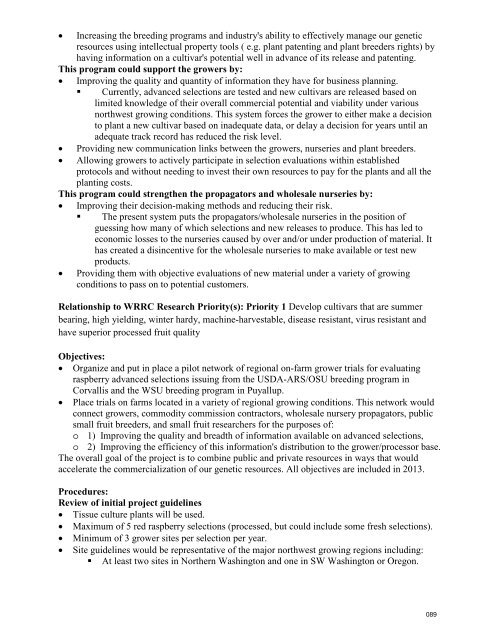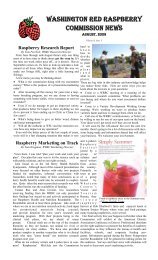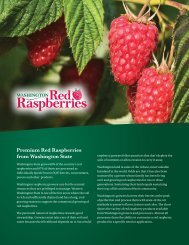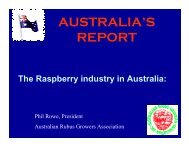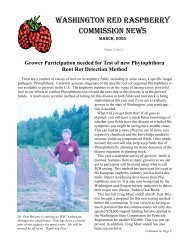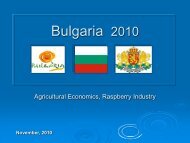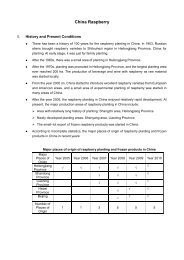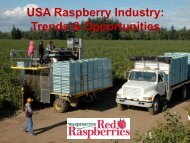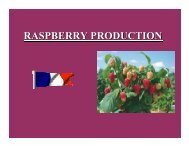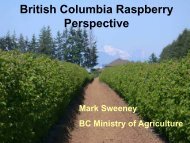2012 - Washington Red Raspberry Commission
2012 - Washington Red Raspberry Commission
2012 - Washington Red Raspberry Commission
Create successful ePaper yourself
Turn your PDF publications into a flip-book with our unique Google optimized e-Paper software.
• Increasing the breeding programs and industry's ability to effectively manage our genetic<br />
resources using intellectual property tools ( e.g. plant patenting and plant breeders rights) by<br />
having information on a cultivar's potential well in advance of its release and patenting.<br />
This program could support the growers by:<br />
• Improving the quality and quantity of information they have for business planning.<br />
• Currently, advanced selections are tested and new cultivars are released based on<br />
limited knowledge of their overall commercial potential and viability under various<br />
northwest growing conditions. This system forces the grower to either make a decision<br />
to plant a new cultivar based on inadequate data, or delay a decision for years until an<br />
adequate track record has reduced the risk level.<br />
• Providing new communication links between the growers, nurseries and plant breeders.<br />
• Allowing growers to actively participate in selection evaluations within established<br />
protocols and without needing to invest their own resources to pay for the plants and all the<br />
planting costs.<br />
This program could strengthen the propagators and wholesale nurseries by:<br />
• Improving their decision-making methods and reducing their risk.<br />
• The present system puts the propagators/wholesale nurseries in the position of<br />
guessing how many of which selections and new releases to produce. This has led to<br />
economic losses to the nurseries caused by over and/or under production of material. It<br />
has created a disincentive for the wholesale nurseries to make available or test new<br />
products.<br />
• Providing them with objective evaluations of new material under a variety of growing<br />
conditions to pass on to potential customers.<br />
Relationship to WRRC Research Priority(s): Priority 1 Develop cultivars that are summer<br />
bearing, high yielding, winter hardy, machine-harvestable, disease resistant, virus resistant and<br />
have superior processed fruit quality<br />
Objectives:<br />
• Organize and put in place a pilot network of regional on-farm grower trials for evaluating<br />
raspberry advanced selections issuing from the USDA-ARS/OSU breeding program in<br />
Corvallis and the WSU breeding program in Puyallup.<br />
• Place trials on farms located in a variety of regional growing conditions. This network would<br />
connect growers, commodity commission contractors, wholesale nursery propagators, public<br />
small fruit breeders, and small fruit researchers for the purposes of:<br />
o 1) Improving the quality and breadth of information available on advanced selections,<br />
o 2) Improving the efficiency of this information's distribution to the grower/processor base.<br />
The overall goal of the project is to combine public and private resources in ways that would<br />
accelerate the commercialization of our genetic resources. All objectives are included in 2013.<br />
Procedures:<br />
Review of initial project guidelines<br />
• Tissue culture plants will be used.<br />
• Maximum of 5 red raspberry selections (processed, but could include some fresh selections).<br />
• Minimum of 3 grower sites per selection per year.<br />
• Site guidelines would be representative of the major northwest growing regions including:<br />
• At least two sites in Northern <strong>Washington</strong> and one in SW <strong>Washington</strong> or Oregon.<br />
089


